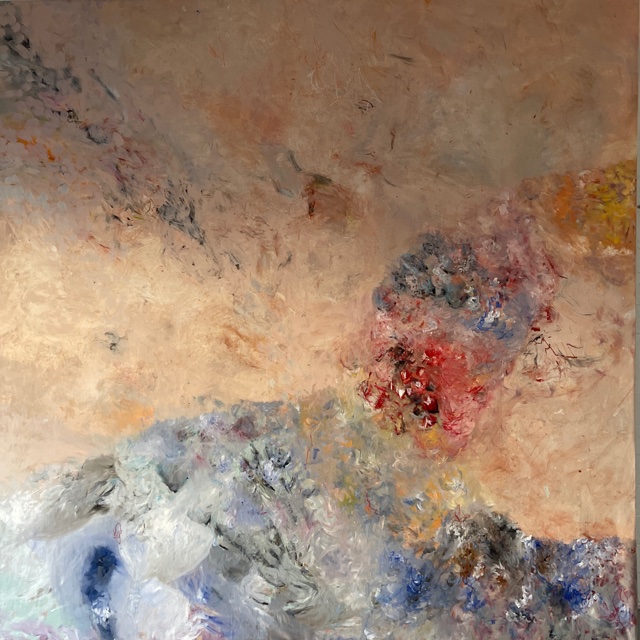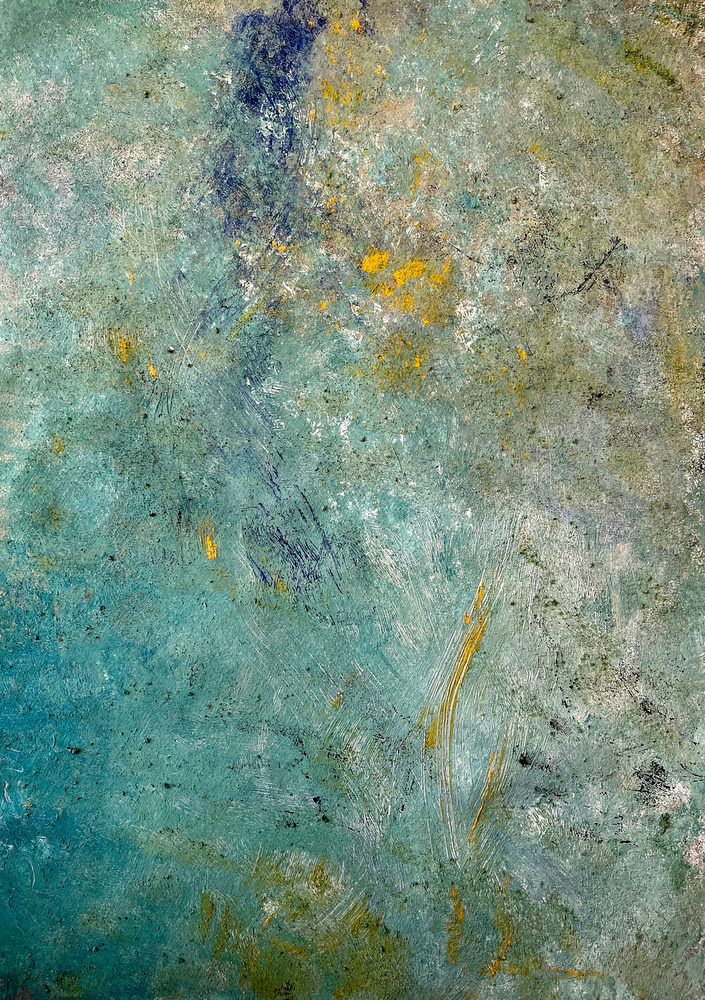Living Poetic Abstraction: In Conversation with Stephanie Cime

On the occasion of her solo exhibition REBIRTH at Balthasar Brussels, Kisito Assangni discussed with Stephanie Cime on the process behind what he describes as "stunning works" presented in the show.
The rich universe of painter Stephanie Cime oscillates between abstraction and meditation. For her, art is the pinnacle of interpersonal communication at a level that transcends cultural, intellectual and philosophical backgrounds and conventions.
On the occasion of her solo exhibition REBIRTH at Balthasar Brussels, Kisito Assangni had the opportunity to ask her some questions about her stunning work.
What do you find special about abstract painting?
“Abstract” painting allows me to experience total freedom. I mean this very literally, not only as in “freedom to paint what I want” but as in freedom as an immersive and all comprehensive feeling. There is no other activity or thought that can provide me with this direct experience of freedom. This naturally translates itself in that there are no aesthetic boundaries or rules that I deliberately abide by. I’m not guided by anything else but my inner world.
You said “I strive to enter a place that we cannot reduce to words or grasp with our thoughts. That part we only can reach by truly allowing and accepting the moment as it is’’. What role do you want to have in society as an artist?
Some artists make art to make people raison, others to provoke, some to shock, others bring innovation, etc.
For me it is being able to touch viewers in a sense that the viewer is invited to reconnect with “his/her essence”. I call this essence “the little quiet place within ourselves”. There, we transcend rational thought. We enter a moment of utter silence…Very hard to grasp with words.
This is also the part of me that I wish to express, that I attain through this experience of total freedom when making my pieces. Therefore I also call this “the process of liberation of my essence”.
My mission is successful if I can let people reconnect (even for a brief moment) with their little quiet place. A moment of piece and freedom in an ever accelerating society.
It is natural that when experiencing art we can feel the energy that the artist has put into the work. It is a subconscious conversation that is going on between the artist and the viewer in a sense that the art “talks” to the viewer on a subconscious level. Moving directly to the subconscious, surpassing rational thought.
Every human being is born with her or his unique way of expressing their essence. It is something that we tend to forget over time because of social, political, practical or any other reason. Going back to this essence is a very honest and straightforward process because it does not involve any external factor such as social norms or outside expectations. In a way you could compare it to going back to our childhood dreams. This is the way from the head to the heart.

Liber7, Mixed media on linen canvas, 205cm x 205cm, 2021
How do you define “mixed media,” and how does that support your work visually?
For me this is again a question of freedom. The experience of true and total freedom naturally also expands to the materials that I use as how I use them when making my pieces. So naturally I choose the media which I work with very intuitively even instinctively, with as less boundaries as possible. Even in this early stage, it is a conversation…between myself and the emerging piece.
Without limitation, the materials I work with are ever expanding… acrylic paint, oil paint, gouache, dry pastel, oil pastels, pencils, aquarelle paint, sand, pieces of rug, paper, (plastic) waste, sand, soil, rocks, etc…
The materials I use and how I use them, I call it “my arsenal” of expression.
There are many descriptions of the ideal state of mind for being creative. What is it like for you?
For me, the ideal creative state is a flow state, a kind of meditative state as you wish to call it that way, where you can fully express your inner world without the critical mind spoiling the game, totally emerged in the “now”.
But this is easier said then done. I believe that this involves a certain way of living, that is nothing less then a non-stop devotional act which is enhancing and stimulating for the creative process. This is because I strive to have a pure conversation with my art, and as a derivative with the viewers. Of course I can never non-relate to my subjective person which means that I am always inside this concrete body and living in this concrete time and space.
Why not compare this with the life of an athlete that devotes almost every waking and sleeping minute to his or her cause. He dreams about it, thinks about it, puts in the effort for training and leads a very healthy lifestyle to ensure the best physical and outstanding performance possible.
For me there is no difference. I also strive to devote myself to my art. And this also includes a certain lifestyle that enhances to be in contact with my silent place, there were there are no thoughts. I truly believe that all form of creation comes from this place. This is a life emerging activity, not a standalone act. This starts from the moment I get up. I try to live my life in coherence with (how i create) my art. The more effort I put into it, the more I feel that this influences my work. And when I slip up, you can see this reflection in my art. Everything is important, from how I relate to other people, to what I eat and what I read and do for sports. I see this as truly essential for my work. Making these pieces is not something I “do”, it is something “I am” from the deepest core of my being.
Many people are interested in art but feel too busy to immerse themselves. What is your advice on how to integrate art into our lives, even if it’s in a small way?
For me, you do not look at art, you experience art. It’s a conversation from an artist to the canvas and from the viewer with the canvas afterwards. Viewers are invited to engage in this (mostly subconscious) conversation.
Of course each viewer is an individual, living in a concrete unique time, situation and has its own subjective ideas which will influence the way how he sees and converse with the work. I find this a very dynamic and fascinating process. It all starts with an intention, the intention to let the art speak to you and to allow yourself to respond instinctively, naturally. To let your “gut” speak, allow yourself to feel whatever comes up.
At first this will feel weird, but after a while you will be able to reconnect with your subconscious reactions towards the art more deeply and profoundly.
Just allow this interaction to happen. Start small, one little step at a time, enjoy the process.
 Surlevent 3, Mixed media on handmade cotton paper, 58cm x 78cm, 2020
Surlevent 3, Mixed media on handmade cotton paper, 58cm x 78cm, 2020
Your pieces are very striking, so what is the best feedback you’ve received about your art?
The best feedback is when people are open and allow the transfer of energy or conversation to happen. When people are open to my work, they experience it as a whole and allow themselves to engage in the conversation with my pieces. When this happens, all feedback is a gift.
That said, I find it interesting that I get the following comment on my art a lot: ”it feels like freedom”: reflecting my inner state when making my pieces.
Thanks again for providing ArtDependence with this opportunity to interview you. Would you mind sharing with us your future goals and ambition?
I constantly seek to expand my arsenal and skills to express my inner self in every way possible. My future pieces in their most pure and full version are already in this very room, silent and waiting to get expressed. Just how they get expressed in form, depends on the tools and techniques (my arsenal) that I will use in the future. This is my constant quest and journey, the creative dynamic force inside of me, the reason why I make art.
It would be my wish to touch as much people as possible with my pieces and to inspire them to look inside and explore their unique essence.
